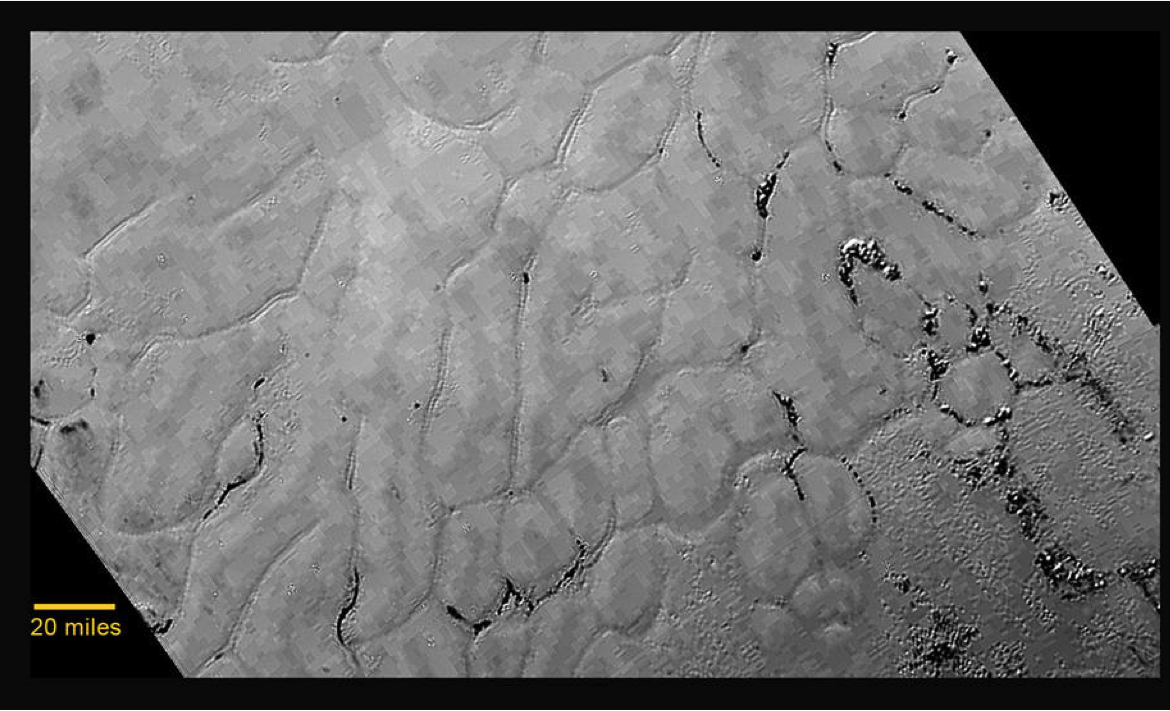Signs of active geology on the dwarf planet…
NASA has unveiled another of the striking images its New Horizons spacecraft took during its Pluto flyby on July 14, showing in exquisite detail a smooth icy plain at the center left of a light-colored, heart-shaped region which has become symbol for the dwarf planet in the public mind.
A day earlier, NASA had released pictures showing mountains of ice, some as high as 3500 meters, on the equatorial belt at the base of the “heart” and the young face of Charon, Pluto’s biggest moon, traversed by a 1000 kilometer system of fractures and scarps.
Spokesmen for the New Horizons team said like the mountains, the uncratered plain appeared to be 100 million-year-old at most and that the geological activity which gave rise to these unexpected features could still be going on.
Passing 12,500 kilometers above Pluto’s surface after a 9.5-year, 5 billion-kilometer voyage, New Horizons headed deeper into the “Kuiper Belt”, the disk-shaped reservoir of comets and other debris from the formation of the Solar system 4.56 billion years ago, outside Neptune’s orbit.
The team unofficially named the heart-shaped region “Tombaugh Regio” after Clyde Tombaugh who had discovered Pluto in 1930, and the icy plain as “Sputnik Planum” after the Earth’s first artificial satellite launched in 1957. The mountains, meanwhile, were named Norgay mountains after Sherpa guide Tenzing Norgay who had first scaled Mt. Everest.
The image taken from a distance of 77,000 kilometers shows the plain is divided into cell-like portions 20-30 kilometers wide, ringed by shallow ditches, some of which is fillled with some dark substance. Unable to come forth with a firm explanation, New Horizons scientists speculate that the cells could be a result of contraction of the plain after its formation like what happens to drying mud, or convection from Pluto’s relatively warmer interior rising through surface layers of methane, nitrogen and carbon monoxide. As for the mountains, they are thought to be formed of water ice which would be no less harder than rock at Pluto’s surface temperatures of – 223 to –233°C.
The team experts say the collection of pits seen at the lower right of the plain’s image could have formed when volatile ices “sublimated” directly into gas without an intermediate stage of liquid form in the absence of adequate atmospheric pressure. Dark lines aligned in the same direction could be the work of winds sweeping the surface.
Another important discovery is the extent of Pluto’s atmosphere, which was detected at 1000 kilometers above the surface, some of which forms a cold and dense tail behind Pluto, formed of ions pushed off by the solar wind.
REFERENCES
- 1. “Frozen Plains in the Heart of Pluto’s 'Heart'”, NASA, 17 July 2015
- 2. “Pluto Wags its Tail: New Horizons Discovers a Cold, Dense Region of Atmospheric Ions Behind Pluto”, NASA, 17 July 2015


